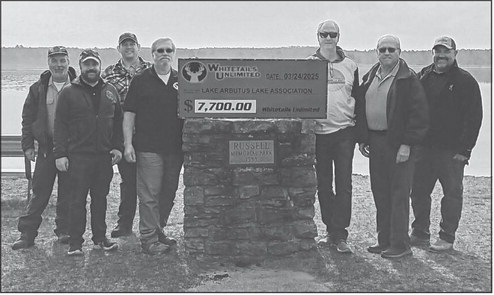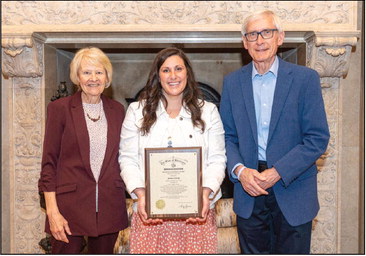Whitetails Unlimited funds eradication of invasive phragmites


By June Thompson, Clark County Press Lake Arbutus and Russell Memorial Park Campground have been a popular place to camp, fish, and swim for more than five decades. People come from miles away to enjoy the campground park and Lake Arbutus in summertime. Winter sports enthusiasts enjoy activities on the lake such as races and ice fishing.
In this natural environment, there are invasive species. One of them is phragmites. The Lake Arbutus Association hopes to eradicate this prominent invasive species.
Paul Reding, president of the Lake Arbutus Association, originally spoke with administrators from Clark County Forestry and Parks, Jackson County Forestry and Parks, and the Department of Natural Resources (DNR) to discuss a solution to eradicating the invasive species. After much discussion, a plan was agreed upon for the three entities to split the cost of the treatments over a three-year period.
However, when Roger Zvolena of the Whitetails Unlimited Clark County North Chapter read an article published in the Clark County Press (March 2025) about the plan to eradicate the invasive species, he asked the organization for grant money to help fund the project. Whitetails Unlimited agreed to fund the entire project, costing $7,700.
“It’s about partnership—people being able to come together,” said Reding.
He contacted Curtiss Lindner (Clark County Forestry and Parks Department administrator), Nate Beaver (Clark County parks and programs manager), Jim Zahasky (Jackson County Forestry and Parks Department administrator), and Jeremy Breheim (Jackson County parks manager), and asked them to be involved with this project.
One of Reding’s other contacts was Ralph Johnson. “He spearheaded this effort to stay on top of the invasive species,” said Reding.
Johnson has over four decades of knowledge concerning Lake Arbutus and Russell Park Campground. He is aware of the invasive species.
“Five years ago, we noticed them. Phragmites are growing uncontrollably; they’re so aggressive,” he said. “We have a company— Quercus Land Stewardship Services from Black Earth will use a chemical approved by the DNR.”
The spraying will start in the fall. “They’ll come out in canoes and flat-bottom boats and go along the shoreline,” said Johnson. “The vines go under the water. Tentacles grow 10-12 feet, to the bottom of the lake.”
Johnson stated the phragmites will be bundled and sprayed.
“It’s a two-day treatment every fall for three years.” Phragmites aren’t the only invasive species on Lake Arbutus. According to Johnson, there are others: purple loosestrife, Japanese knotweed, and yellow iris. He encouraged owners to clean their boats and other water recreational equipment to lower the possibility of transferring an invasive species to the lake.
Lake Arbutus was officially dedicated in July 1908. The name came from the Trailing Arbutus seen around the lake—wiclarkcountyhistory.org. Non-native invasive phragmites or common reed (phragmites australis), is a perennial wetland grass that grows 3 to 20 feet tall. It invades lakeshores and riverbanks. It can quickly become established, taking over underground. The rhizomes store energy so that the plant can recover from cutting, burning, or grazing. It alters wildlife habitat and shades native species. It can spread through root fragmentation above ground. Control: Use the bundle cut method in late summer/fall and chemicals. Prevent the spread by cleaning boats and water sports equipment— DNR.
CONTRIBUTED PHOTO



